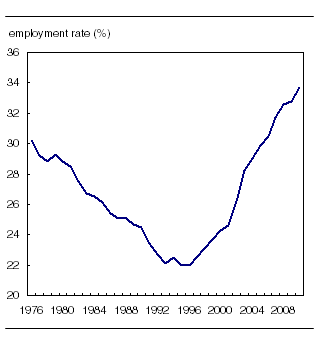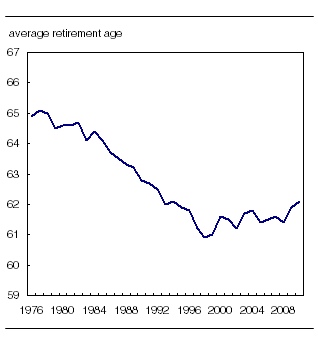Study: Delayed retirement
Archived Content
Information identified as archived is provided for reference, research or recordkeeping purposes. It is not subject to the Government of Canada Web Standards and has not been altered or updated since it was archived. Please "contact us" to request a format other than those available.
Related subjects
-
[an error occurred while processing this directive]
A 50-year-old worker in 2008 could expect to stay in the labour force 3.5 years longer than in the mid-1990s, according to an indicator that tracks the retirement behaviour of Canadians.
Using Labour Force Survey data, this indicator estimates the number of years a 50-year-old worker can expect to work before retiring, if retirement rates of a given year prevail. Expected working life is estimated using a method similar to that used for calculating life expectancy.
According to the indicator, older workers have been increasingly delaying their retirement since the mid-1990s. This is consistent with the increase in the employment rate of older Canadians that began about the same time.
According to this measure, in 2008, an employed 50-year-old had an expected additional 16 years at work. This is roughly 3.5 years longer than workers of the same age in the mid-1990s, who could expect to work 12.5 more years. The 3.5-year increase was the same for both men and women.
During the 1980s and early 1990s, there was a marked trend toward early retirement prompted by high public-sector deficits and downsizing among private-sector organizations. However, since the mid-1990s, the tide appears to have turned.
From a low of 22% in 1996, the employment rate of individuals 55 and older climbed steadily to 34% in 2010. Their employment rate in 2010 was even higher than in 1976 when it stood at 30.2%.
Employment rate trend for people 55 and over reversed in the mid-1990s

Chart description: Employment rate trend for people 55 and over reversed in the mid-1990s
Length of time in retirement
Even though they are delaying their retirement, Canadians are not necessarily spending less time in retirement.
The trend to delayed retirement has had the impact of stabilizing the expected length of retirement. That is because of a similar increase in life expectancy.
The expected length of retirement increased from 1977 to the mid-1990s and has remained relatively stable since. Between 1977 and 1994, the expected time men would spend in retirement increased sharply from 11.2 year to 15.4 years. In 2008, it was 15 years.
The trend for women was similar. Between 1977 and 1996, the estimated years of retirement for women rose from 16.4 to 20.6. In 2008, women would spend 19 years in retirement.
As a percentage of total life expectancy, the expected length of retirement from the age of 50 was about the same in 2008 as it was in 1977.
In 2008, 50-year-old men could expect to spend 48% of their remaining years of life in retirement, compared with 45% in 1977. In 2008, 50-year-old women could expect to spend 55% of their remaining years of life in retirement, nearly identical to the proportion in 1977.
Employment rates
The employment rate of individuals aged 55 and over has increased substantially in recent years. Between 1997 and 2010, the rate went from 30.5% to 39.4% for men and from 15.8% to 28.6% for women.
This strong growth appears at odds with the stability of the average retirement age. Since 2004, it has remained at about 62.
The study shows that average retirement age is relatively insensitive to a trend change towards delayed retirement. Moreover, it is also affected by the age structure of the older workforce. And the age structure is changing rapidly due to the influx of the baby boomers. Thus average retirement age has not accurately reflected recent changes in retirement behaviour.
Average retirement age stable since 2004

Chart description: Average retirement age stable since 2004
Hours of work
Delayed retirement could moderate some of the economic challenges of population aging. However, hours of work must be considered, since a drop of hours could partly offset the impact of an increased expected work life on annual hours and economic growth.
Individuals aged 55 and over reduced their average work week by one hour between 1997 and 2010.
On its own, growth in the 55-and-over population would have increased annual hours by 48% between 1997 and 2010. However, annual hours actually increased by 87% over this period.
Therefore, this study shows that the increase in delayed retirement since the mid-1990s has had a large positive impact on annual hours despite the decrease in average weekly hours.
Note: This article is based on data from the Labour Force Survey (LFS) as well as working-life tables calculated using a method similar to the one used for calculating life expectancy. The working-life tables are based on retirement rates calculated using the LFS. In this article, older workers are those aged 55 and over. However, the working-life tables are based on the population aged 50 to 80, since this is the age group covering most retirements. The findings of this study apply to the 10 provinces, since data for the Northwest Territories, Yukon and Nunavut are not included.
Definitions, data sources and methods: survey number 3701.
The article "Delayed retirement: A new trend?" is now available in the online edition of Perspectives on Labour and Income, Vol. 23, no. 4 ( (75-001-X, free), from the Key resource module of our website under Publications.
For more information, or to enquire about the concepts, methods or data quality of this release, contact Diane Galarneau (613-951-4626; fax: 613-951-2869), Labour Statistics Division.
Also available in this edition of Perspectives on Labour and Income is "Unionization 2011," which presents the latest facts and figures on unionization rates in Canada.
For more information on this article, or to enquire about the concepts, methods or data quality of this release, contact Sharanjit Uppal (613-951-3887; sharanjit.uppal@statcan.gc.ca), Labour Statistics Division.
For more information on Perspectives on Labour and Income, contact Ted Wannell (613-951-3546; ted.wannell@statcan.gc.ca), Labour Statistics Division.
- Date modified:
